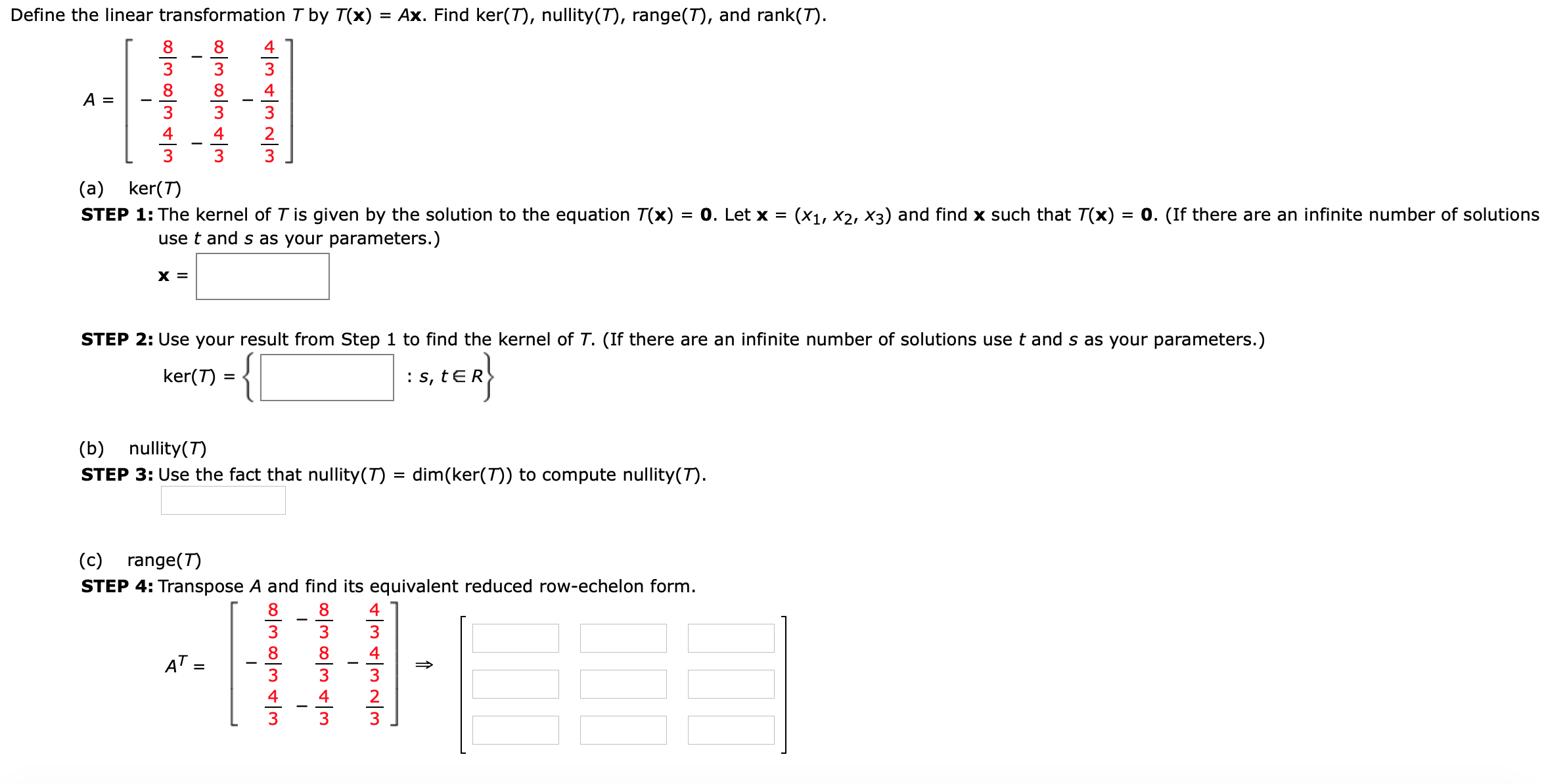Define the linear transformation T by T(x) = Ax. Find ker(T), nullity(T), range(T), and rank(T). %3D 8 8 4 3 3 3 8 8 4 A = 3 3 3 4 2 3 4 - 3 3 (a) ker(T) STEP 1: The kernel of T is given by the solution to the equation T(x) = 0. Let x = (x1, x2, X3) and find x such that T(x) = 0. (If there are an infinite number of solutions %3D use t and s as your parameters.) X = STEP 2: Use your result from Step 1 to find the kernel of T. (If there are an infinite number of solutions use t and s as your parameters.) eR} ker(T) = { : s, tER (b) nullity(T) STEP 3: Use the fact that nullity(T) = dim(ker(T)) to compute nullity(T). (c) range(T) STEP 4: Transpose A and find its equivalent reduced row-echelon form. 8 4 3 3 3 8 8 4 AT = - 3 3 3 4 4 2 3 3
Define the linear transformation T by T(x) = Ax. Find ker(T), nullity(T), range(T), and rank(T). %3D 8 8 4 3 3 3 8 8 4 A = 3 3 3 4 2 3 4 - 3 3 (a) ker(T) STEP 1: The kernel of T is given by the solution to the equation T(x) = 0. Let x = (x1, x2, X3) and find x such that T(x) = 0. (If there are an infinite number of solutions %3D use t and s as your parameters.) X = STEP 2: Use your result from Step 1 to find the kernel of T. (If there are an infinite number of solutions use t and s as your parameters.) eR} ker(T) = { : s, tER (b) nullity(T) STEP 3: Use the fact that nullity(T) = dim(ker(T)) to compute nullity(T). (c) range(T) STEP 4: Transpose A and find its equivalent reduced row-echelon form. 8 4 3 3 3 8 8 4 AT = - 3 3 3 4 4 2 3 3
Linear Algebra: A Modern Introduction
4th Edition
ISBN:9781285463247
Author:David Poole
Publisher:David Poole
Chapter6: Vector Spaces
Section6.5: The Kernel And Range Of A Linear Transformation
Problem 4EQ
Related questions
Question


Transcribed Image Text:Define the linear transformation T by T(x) = Ax. Find ker(T), nullity(T), range(T), and rank(T).
%3D
8
8
4
3
3
3
8
8
4
A =
3
3
3
4
2
3
4
-
3
3
(a) ker(T)
STEP 1: The kernel of T is given by the solution to the equation T(x)
= 0. Let x =
(x1, x2, X3) and find x such that T(x) = 0. (If there are an infinite number of solutions
%3D
use t and s as your parameters.)
X =
STEP 2: Use your result from Step 1 to find the kernel of T. (If there are an infinite number of solutions use t and s as your parameters.)
eR}
ker(T) = {
: s, tER
(b) nullity(T)
STEP 3: Use the fact that nullity(T) = dim(ker(T)) to compute nullity(T).
(c) range(T)
STEP 4: Transpose A and find its equivalent reduced row-echelon form.
8
4
3
3
3
8
8
4
AT =
-
3
3
3
4
4
2
3
3
Expert Solution
This question has been solved!
Explore an expertly crafted, step-by-step solution for a thorough understanding of key concepts.
This is a popular solution!
Trending now
This is a popular solution!
Step by step
Solved in 3 steps with 12 images

Knowledge Booster
Learn more about
Need a deep-dive on the concept behind this application? Look no further. Learn more about this topic, advanced-math and related others by exploring similar questions and additional content below.Recommended textbooks for you

Linear Algebra: A Modern Introduction
Algebra
ISBN:
9781285463247
Author:
David Poole
Publisher:
Cengage Learning

Elementary Linear Algebra (MindTap Course List)
Algebra
ISBN:
9781305658004
Author:
Ron Larson
Publisher:
Cengage Learning

College Algebra
Algebra
ISBN:
9781305115545
Author:
James Stewart, Lothar Redlin, Saleem Watson
Publisher:
Cengage Learning

Linear Algebra: A Modern Introduction
Algebra
ISBN:
9781285463247
Author:
David Poole
Publisher:
Cengage Learning

Elementary Linear Algebra (MindTap Course List)
Algebra
ISBN:
9781305658004
Author:
Ron Larson
Publisher:
Cengage Learning

College Algebra
Algebra
ISBN:
9781305115545
Author:
James Stewart, Lothar Redlin, Saleem Watson
Publisher:
Cengage Learning

Algebra and Trigonometry (MindTap Course List)
Algebra
ISBN:
9781305071742
Author:
James Stewart, Lothar Redlin, Saleem Watson
Publisher:
Cengage Learning